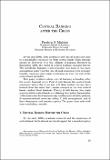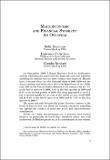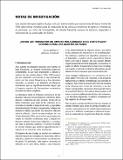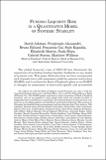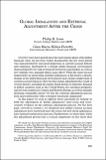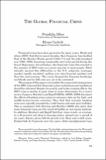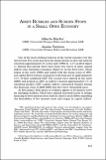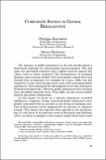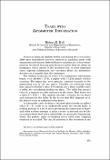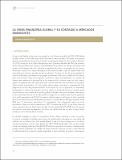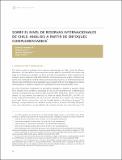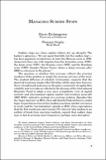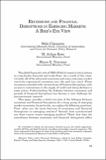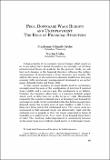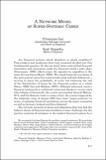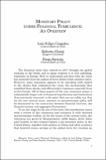Buscar
Mostrando ítems 1-20 de 49
Modeling a housing and mortgage crisis
The current crisis has centered on borrower defaults on mortgages and the associated effects on banks’ own credit standing (and in several cases their own default), which in turn led to tightened conditions for lending to new (mortgage) borrowers. Any model that does not incorporate all or most of ...
Central banking after the crisis
By the mid-2000s both academics and central banks had come to a remarkable consensus on what central banks’ basic strategy should be. However with the collapse of Lehman Brothers in September 2008 the world of central banking changed forever. The worldwide financial crisis revealed that some of the ...
Macroeconomic and financial stability: an overview
On September 2008 Lehman Brothers filed for bankruptcy and the world became aware that the financial crisis that had been unfolding for months was far more serious than expected. Months later it became clear that the financial crisis of 2008-2009 was the worst economic downturn since the Great Depression ...
¿Tienen los terremotos un impacto inflacionario en el corto plazo? evidencia para una muestra de países
Aun cuando los desastres naturales son eventos de baja frecuencia, su impacto económico puede ser considerable, lo que hace importante su estudio y análisis. En este sentido, Barro (2006, 2009) destaca que las catástrofes económicas de baja frecuencia, como son las crisis financieras y los desastres ...
Crisis financiera y uso de derivados cambiarios en empresas exportadoras
La reciente crisis financiera internacional ha generado varias interrogantes sobre sus efectos en el comercio internacional; en especial, respecto de los mecanismos por los que el sector exportador ha visto resentido su dinamismo y de si las firmas de menor tamaño han sufrido más. Tradicionalmente, ...
Funding liquidity risk in a quantitative model of systemic stability
The global financial crisis of 2007–09 has illustrated the importance of including funding liquidity feedbacks in any model of systemic risk. This paper illustrates how we have incorporated such channels into a risk assessment model for systemic institutions (RAMSI) and it outlines the Bank of England’s ...
Global imbalances and external adjustment after the crisis
Over five years have passed since the most intense phase of the global financial crisis. As has been widely documented the pre-crisis period was characterized by increased dispersion in current account deficits and surpluses facilitated by a benign global financial environment characterized by low ...
The global financial crisis
Financial crises have been pervasive for many years. Bordo and others (2001) find that in recent decades their frequency has doubled that of the Bretton Woods period (1945–71) and the gold standard era (1880–1993) becoming comparable only to the period during the Great Depression. Nevertheless the ...
Asset bubbles and sudden stops in a small open economy
One of the most striking features of the world economy over the last twenty-five years has been the sharp decline in the real interest rate from approximately 4% in the early 1990s to -1.5% in 2013 (figure 1). During this period there have been two waves of large capital inflows into emerging economies ...
Corporate saving in global rebalancing
The increase in global imbalances in the last decade posed a theoretical challenge for international macroeconomics. Why did some less developed countries with a higher need for capital like China lend to richer countries? The inconsistency of standard dynamic open-economy models with actual global ...
Spillovers to emerging markets during global financial crisis
At the heart of the debate on how the 2007–09 global financial crisis spread from the United States to the rest of the world lies the global banks. Using a large sample composed of advanced and emerging economies since the 1980s Abiad and others (2013) show that the effect of financial linkages on ...
Trade with asymmetric information
Events in financial markets before and during the crisis of late 2008 have stimulated renewed interest in modeling trade with asymmetric information. Robert Shimer’s contribution to this volume joins the literature focusing on trade in securities that are claims on mortgages where issuers of the ...
La crisis financiera global y contagio a mercados emergentes
Estudiamos el efecto de los vínculos entre bancos en el contagio de los ciclos productivos con un enfoque específico en la propagación de la crisis de 2007-2009 desde los países avanzados hacia los emergentes. En una muestra de pares de países compuesta de 17 economías avanzadas y 11 emergentes entre ...
Sobre el nivel de reservas internacionales de Chile: análisis a partir de enfoques complementarios
Este artículo analiza la evolución y el nivel de reservas internacionales de Chile a partir de metodologías complementarias. En primer lugar, construimos diversos indicadores de reservas internacionales sugeridos por la literatura para un conjunto de países avanzados y emergentes. Segundo, estimamos ...
Managing sudden stops
Sudden stops are when capital inflows dry up abruptly. The banker’s aphorism—'It’s not speed that kills but the sudden stop'— has been popularly invoked since at least the Mexican crisis in 1994. Awareness then rose with impetus from the Argentine crisis (1995) the Asian crisis (1997) the Russian ...
Recessions and financial disruptions in emerging markets: a bird's eye view
The global financial crisis of 2008–09 led to massive interruptions in cross-border financial and trade flows. As a result of the crisis virtually all of the advanced economies and many emerging market countries experienced recessions over the past two years. These recessions coincided with various ...
Monetary policy under financial turbulence: an overview
The financial crisis that started in 2007 brought the global economy to the brink and in many respects it is still unfolding especially in Europe. How to understand and deal with the crisis has naturally been the subject of fierce debates that continue today. However some consensus appears to be ...
Pegs downward wage rigidity and unemployment: the role of financial structure
A characteristic of the current crisis in Europe is that countries in its periphery have found themselves increasingly cut off from international financial markets. In the present study we ask how such changes in the financial structure influence the welfare consequences of maintaining a fixed exchange ...
A network model of super-systemic crises
Are financial systems shock absorbers or shock amplifiers? Policymakers and academics have long remained divided over this fundamental question. On the one hand some contend that financial innovation and integration make the financial world a safer place (Greenspan 1999) others argue the opposite by ...
Monetary policy under financial turbulence
The financial crisis that started in 2007 brought the global economy to the brink, and in many respects it is still unfolding, especially in Europe. While a fierce debate continues on how to understand and deal with the crisis, a consensus is emerging with regard to the originating shocks, the mechanisms ...


